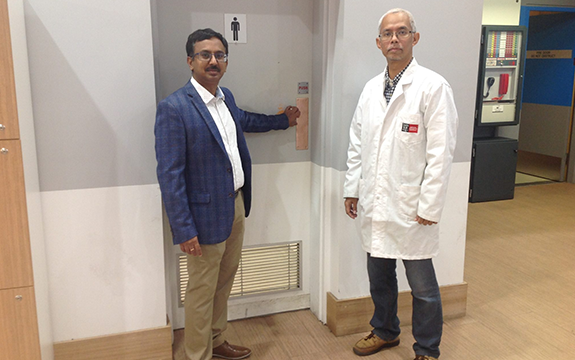Coronavirus-fighting copper printed and installed at Swinburne

In Summary
- Swinburne has worked with manufacturer SPEE3D to 3D print and trial copper door push plates that fight COVID-19 at its Hawthorn campus
- Tests have shown that anti-microbial copper surfaces can kill 96 per cent of the virus that causes COVID-19, SARS-CoV-2, in just two hours.
Swinburne has worked with Australian manufacturer SPEE3D to trial copper door push plates that fight COVID-19 at its Hawthorn campus.
SPEE3D has successfully developed and tested a fast and affordable way to 3D print anti-microbial copper onto metal surfaces. Laboratory tests have shown that touch surfaces modified by this process ‘contact kills’ 96 per cent of the virus that causes COVID-19, SARS-CoV-2, in just two hours.
The material, known as ‘ACTIVAT3D copper’, has been developed by modifying SPEE3D’s 3D printing technology, using new algorithms to control their metal printers and allow existing metal parts to be coated with copper. Copper parts are difficult to produce using traditional methods and 3D printing is one of the only tools available to rapidly deploy copper.
“Swinburne University of Technology in partnership with SPEE3D quickly responded to the current situation and manufactured ACTIVAT3D copper push plates in a short timeframe,” says Swinburne Associate Professor Suresh Palanisamy.
“Using the LightSPEE3D printer in our Factory of the Future we have successfully coated a number of existing stainless steel plates and confirmed the speed and ease of this coating process. Further, trial installations have clearly demonstrated the simplicity and practicality of replacing conventional stainless steel with the new ACTIVAT3D plates.”
With laboratory testing complete, it’s hoped this Australian-developed breakthrough can be applied to frequently touched items like door handles, rails and push plates in hospitals, schools and other public places.
SPEE3D CEO, Byron Kennedy, says the company focused on developing a solution that can be rapidly deployed and is more efficient than printing solid copper parts from scratch.
“The lab results show ACTIVAT3D copper surfaces behave much better than traditional stainless steel surfaces and this may offer a promising solution to a global problem. The technology can be used globally, addressing local requirements be they in hospitals, schools, on ships or shopping centres.”
SPEE3D developed the unique technique to harness copper’s proven ability to eradicate bacteria, yeasts and viruses rapidly on contact. This is compared to traditional surfaces like stainless steel and plastic, with recent studies showing that SARS-CoV-2 can survive on these materials for up to three days.
To validate its abilities to combat COVID-19, copper samples printed by SPEE3D have been lab tested a. The SPEE3D team developed a process to coat a stainless-steel door touch plate and other handles in just 5 minutes.
The digital print files were then sent to participating partners around the globe, allowing the simultaneous installation of newly-coated parts in buildings in the USA, Asia and Australia, including at Swinburne.

